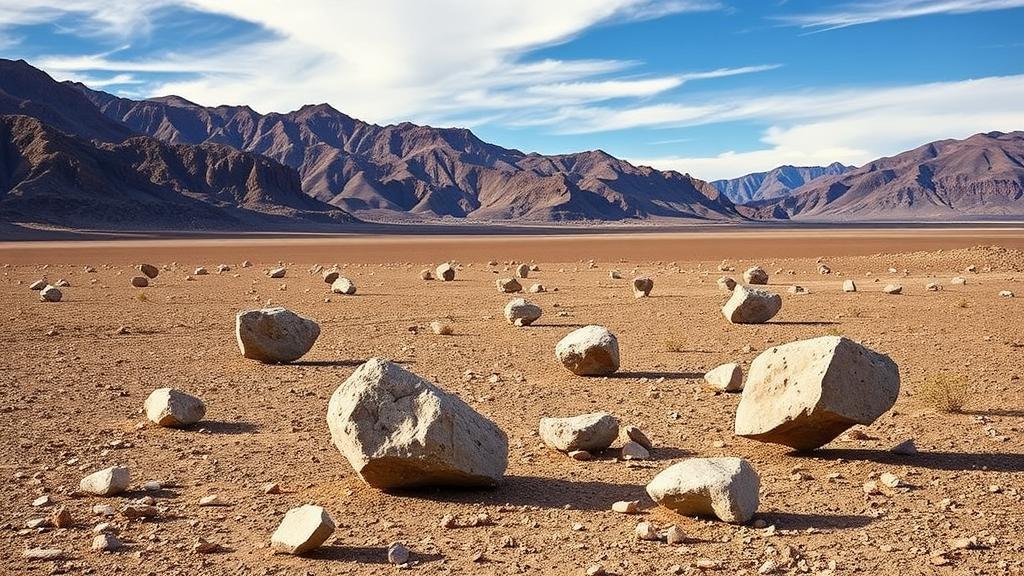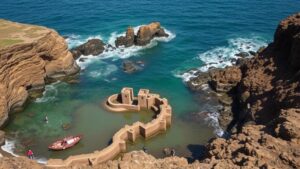Searching for the cause of the sailing stones of Death Valley, which mysteriously move across the desert.
The Mysterious Sailing Stones of Death Valley
Death Valley, California, known for its extreme temperatures and desolate beauty, holds a curious natural phenomenon that has baffled scientists and visitors alike for decades–the sailing stones. These stones, which can weigh hundreds of pounds, appear to move autonomously across a dry lakebed, leaving behind long, enigmatic tracks in the cracked earth. This article explores the cause behind this intriguing phenomenon, examining the scientific studies that seek to unravel its mystery.
A Historical Overview
The sailing stones were first reported in the early 20th century. Death Valley National Park, established in 1994, is home to the Racetrack Playa, the primary site where these phenomena are observed. Witness accounts date back to the 1910s, but attempts to explain the sailing stones didnt begin in earnest until much later. In 1948, a more systematic study was conducted by geologist Dr. Robert Sharp, who initially hypothesized that the stones moved due to strong winds.
The Science Behind the Sailing Stones
For many years, the movement of the stones remained largely unexplained. It wasnt until 2014 that researchers provided a compelling explanation involving a combination of specific environmental conditions. A team led by physicist Dr. Richard Norris employed a set of scientific observations, which revealed that the movement of the stones coincides with a unique combination of wet conditions and subsequent freezing temperatures.
- The process begins when a rare rain shower moistens the playa, creating a thin layer of water over the surface.
- As the temperatures drop at night, this water can freeze, forming thin sheets of ice around the stones.
- When sunlight returns the next day, the ice begins to melt and breaks apart, causing the stones to be pushed by the wind or slid along wet surfaces, leaving trails behind them.
Real-World Observations
In their study, researchers attached GPS data loggers to a few stones, capturing over 16,000 individual locations. The experiment confirmed that the stones moved across Racetrack Playa at speeds of approximately 3-5 meters per minute during ideal conditions in 2011 and 2013. These findings showcased that the stones do indeed move, albeit rarely, under specific circumstances, rather than being propelled by mysterious forces.
Addressing Common Myths
Despite scientific advancements, several myths about the sailing stones persist, prompting confusion. Some common misconceptions include:
- They are moved by extraterrestrial forces or ghostly energies.
- They move automatically without any environmental influence.
These theories, while entertaining, divert attention from the scientifically verifiable explanations. The combination of wind, water, and ice is a natural phenomenon rooted in the harsh desert environment of Death Valley.
Implications for Future Research
The mystery of the sailing stones raises questions about environmental change and geological studies. Understanding the mechanisms behind their movement can offer insights into similar phenomena in arid regions worldwide. It also emphasizes the importance of continued scientific inquiry in delving into natures mysteries.
Conclusion
The sailing stones of Death Valley represent a unique convergence of natural forces. Through a combination of environmental conditions, researchers have demystified this intriguing phenomenon, transforming it from myth to science. As we continue to explore and study such natural curiosities, we not only enhance our understanding of the Earth’s processes but also deepen our appreciation for the complexities of our natural world.
For those intrigued by the sailing stones, a visit to Racetrack Playa offers a firsthand look at this extraordinary spectacle. With patience and perhaps a bit of luck, you might witness the stones in motion, a reminder of natures enigmatic beauty.



